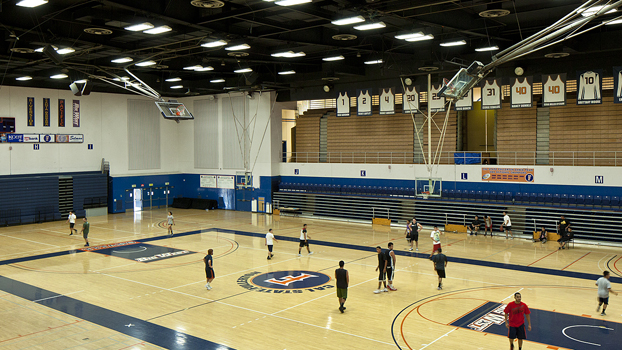 Caption: Basketball players play in Titan Gym following the installation of a more energy efficient lighting system that creates less shadows and glare on the court. Photo courtesy of Energy Solutions/California Energy Commission
Caption: Basketball players play in Titan Gym following the installation of a more energy efficient lighting system that creates less shadows and glare on the court. Photo courtesy of Energy Solutions/California Energy Commission
Lighting Retrofit
Gymnasium Project Saves Energy and Improves Light Quality
Aug. 1, 2012
Athletes and audiences now have a much brighter view of games and matches in Titan Gym, thanks to a project that replaced fixtures and installed a wireless control system.
With the retrofit, the campus was able to reduce the 16,600 square-foot gym’s lighting energy use by 66 percent, cutting energy costs and greenhouse gas emissions while improving light quality and controllability.
“Our overall effort with this and other scheduled projects is to get down to the smallest possible net energy use and reduce Cal State Fullerton’s carbon footprint as much as possible,” said Willem van der Pol, director of facilities operations. “We're taking lots of small steps to gradually get to one big goal.”
Prior to the retrofitting, a single set of switches controlled all the lights, said Jeff Bechtold, building technology specialist. “That meant that often all the lights in the gym were on when there was no need for them — 68 400-watt light fixtures in the on position an average of nearly 16 hours a day, seven days a week almost all year long. Because of that, we were paying about $17,500 annually in electricity costs.”
And the old lighting fixtures were based on outdated technology that created uneven lighting, or shadows, and created a buzzing sound while on, distracting facility users.
The solution was to replace the metal halide fixtures with new fixtures connected to a wireless light management system that allows for a section or sections of lights to be on, or off, at any given time. Also new are sensors to dim and, eventually, shut off the lights in unoccupied areas.
“We went with a wireless lighting control system because it is portable and configurable,” said Doug Kind, manager of engineering and sustainability services. “The controls also are adaptable to changing needs and schedules through simple reprogramming.”
“Not only is it good for reducing the amount of energy that is used, it helps with improving the safety and security within the facility by eliminating dark spots," said Bechtold.
And the wireless system allows select staff members the ability to manually control the lighting, added Bechtold.
The total cost of the project was $70,100. An Energy Technology Assistance Program and Southern California Edison UC/CSU-IOU Statewide Partnership Rebate Program covered 56 percent of the cost.
“The university should recoup the balance of the cost in less than two years,” Bechtold added.
